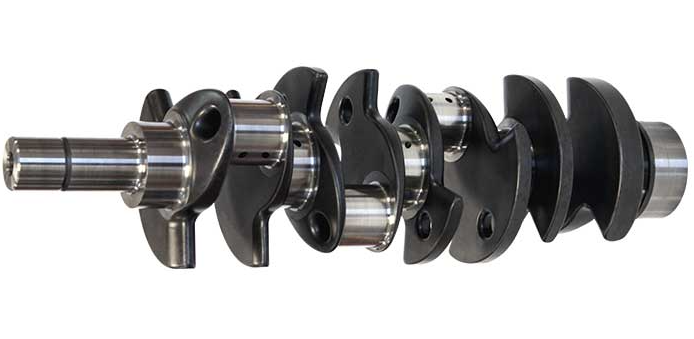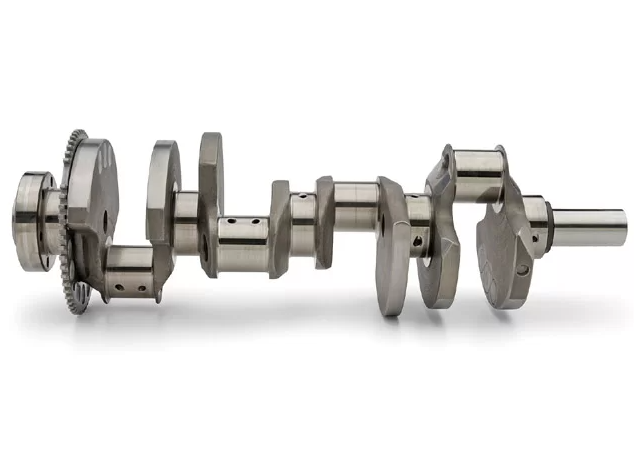Yes, crankshafts can indeed vary by vehicle type.
The design and construction of crankshafts can differ significantly depending on the specific requirements of the vehicle, including its power needs, weight, and the intended use of the vehicle.
Factors such as material selection, engine size and power output, vehicle weight and performance requirements, and manufacturing technology all play a role in these variations.
This article delves into the details of how and why these crankshaft variations occur and their impacts on vehicle performance, fuel efficiency, and engine lifespan.

Introduction
The crankshaft is a critical component in the internal combustion engines of vehicles.
This article will explore the role and importance of crankshafts in vehicles, and how they can vary depending on the type of vehicle. Whether you’re an auto mechanic, an engineer, or a car enthusiast, understanding the intricacies of crankshafts can give you a deeper insight into the workings of vehicles.
The Role and Importance of Crankshafts in Vehicles
A crankshaft is an essential part of an engine that performs a variety of tasks. Its primary role is to convert the reciprocating motion of the pistons into a rotary motion. This transformation is what drives the vehicle’s wheels and makes motion possible. Besides this, the crankshaft also plays a role in the timing of the engine’s valves and can have a significant effect on an engine’s performance and efficiency.
Understanding the functionality and design of crankshafts can help to illuminate how different engine designs can result in varied performance outcomes for different types of vehicles.
Brief Overview of the Article’s Scope
In this article, we will delve into the topic of crankshafts and how they vary based on the type of vehicle, including cars, motorcycles, trucks, marine vessels, and aircrafts. We’ll explore the factors influencing crankshaft design and material selection, the effects of crankshaft design on vehicle performance, and future trends in crankshaft design. Through detailed breakdowns and real-world examples, we aim to provide a comprehensive understanding of this crucial vehicle component.
Understanding Crankshafts
It is essentially the heart of the engine, and understanding its operation is fundamental to comprehending engine mechanics.
Basic Definition and Function of a Crankshaft
A crankshaft is a mechanical part that has the ability to convert reciprocating motion into rotational motion.In its most basic sense, a crankshaft takes the up-and-down movement generated by the combustion process in an engine and translates it into the rotational movement that ultimately turns the wheels of the vehicle.
Detailed Breakdown of the Parts of a Crankshaft and Their Functions
A crankshaft is composed of several parts, each with a specific function.
- Main journals: These are the areas where the crankshaft connects with the rest of the engine (known as the engine block) and where it rotates.
- Connecting rod journals (or simply ‘rods’): These are offset from the main journals and connect to the pistons in the engine. The reciprocating motion of the pistons is transferred to these rods.
- Crankpins: These are areas offset from the axis of the crank, where the connecting rods attach.
- Counterweights: These are used to balance the weight of the rods and pistons.
Understanding these components and how they interrelate is crucial to grasping how a crankshaft functions within an engine.
Understanding the Concept of Crankshaft Design Variation
Crankshaft design can vary significantly, primarily influenced by the type of vehicle and the specific demands of its engine. Factors such as the number of cylinders in an engine, the engine’s configuration, and the desired performance characteristics of the vehicle can all play a role in determining the design of the crankshaft.
Crankshafts in Different Vehicle Types
This is due to a variety of factors including the vehicle’s intended use, power requirements, and engine configuration. Here, we will explore how crankshafts differ across various vehicle types.
Crankshafts in Cars
Cars, being the most common type of vehicle, exhibit a wide range of crankshaft designs based on the specific needs of their engines.
Common Types of Crankshafts Used in Cars
In cars, cast iron and forged steel crankshafts are the most commonly used due to their strength and durability. They are typically found in inline or V-type engines, and their design can differ based on the number of cylinders in the engine. A common example is the flat-plane crankshaft often found in high-performance sports cars, designed to allow the engine to reach higher RPMs.

Factors Influencing Crankshaft Design in Cars
Several factors influence the design of a car’s crankshaft. This includes the power and torque requirements of the vehicle, the type and size of the engine, and the car’s intended use (for example, high-performance cars may require different crankshaft designs compared to economy vehicles).
Crankshafts in Motorcycles
Motorcycle engines often require different crankshaft designs compared to car engines due to their smaller size and different performance needs.
Common Types of Crankshafts Used in Motorcycles
Most motorcycles use single-cylinder or twin-cylinder engines, with crankshafts often made from high-strength steel.
Factors Influencing Crankshaft Design in Motorcycles
Motorcycle crankshaft design is influenced by the motorcycle’s intended use (such as touring, racing, or off-road use), the type and size of the engine, and the desired power and torque characteristics.
Crankshafts in Trucks
Trucks, especially heavy-duty ones, require crankshafts that can withstand high levels of stress and deliver significant amounts of torque.
Common Types of Crankshafts Used in Trucks
Truck engines, which are often larger and generate more power than car or motorcycle engines, typically use robust, cast iron or steel crankshafts.
Factors Influencing Crankshaft Design in Trucks
The design of a truck’s crankshaft is largely determined by the vehicle’s towing capacity, power requirements, the size and type of the engine, and the durability needed for heavy-duty usage.
Crankshafts in Marine Vessels
Marine engines present unique challenges for crankshaft design due to their operating environment and the substantial power outputs required.
Common Types of Crankshafts Used in Marine Vessels
Marine vessel crankshafts are typically large, robust, and designed to withstand the rigors of marine environments.

Factors Influencing Crankshaft Variation
The design and construction of crankshafts can differ significantly depending on several key factors. By understanding these factors, we can better appreciate the intricacies of crankshaft design and its implications on vehicle performance.
Material Selection for Crankshafts and Its Impact
The choice of material for a crankshaft plays a crucial role in determining its performance, longevity, and suitability for different applications. Common materials include cast iron, forged steel, and in some high-performance or specialist applications, composites or high-strength alloys.
- Cast Iron: Cast iron crankshafts are durable, cost-effective, and suitable for a wide range of applications, including in many consumer cars. However, they are heavier and may not withstand the stresses of high-performance engines as well as other materials.
- Forged Steel: Forged steel crankshafts offer superior strength and resistance to wear, making them a popular choice for high-performance cars, trucks, and other heavy-duty vehicles. However, they are more expensive to produce than their cast iron counterparts.
- Composites/Alloys: In some high-performance or specialist applications, composite or alloy materials may be used due to their high strength-to-weight ratio. However, these materials are typically more expensive and require more complex manufacturing processes.
The Role of Engine Size and Power Output
The size of an engine and its power output also influence the design of a crankshaft. Larger, more powerful engines typically require stronger, more durable crankshafts that can withstand the increased stresses produced by higher combustion pressures. The configuration of the engine (i.e., inline, V-type, flat, etc.) will also affect the crankshaft design.
Impact of Vehicle Weight and Performance Requirements
The weight of a vehicle and its performance requirements are further considerations in crankshaft design.On the other hand, heavier vehicles or those requiring high torque (such as trucks or utility vehicles) may require more robust, heavier crankshafts to withstand the greater loads and stresses involved.
The Influence of Manufacturing Processes and Technology
Finally, the manufacturing processes and technology used can also influence crankshaft design. For example, advancements in forging technology have enabled the production of stronger, more complex crankshaft designs without a significant increase in cost. In addition, Computer Numerical Control (CNC) machining allows for high precision in the production of crankshafts, contributing to increased engine efficiency and performance. Future developments in manufacturing technology will continue to impact crankshaft design and capabilities.
Effects of Crankshaft Variation on Vehicle Performance
Crankshaft design variations not only contribute to the overall characteristics of different types of vehicles, but they also directly impact vehicle performance. This section explores the effects of these variations on engine performance, fuel efficiency, and engine lifespan.
How Crankshaft Design Affects Engine Performance
The design of the crankshaft plays a pivotal role in determining an engine’s performance characteristics. For instance, the mass and shape of the crankshaft can significantly influence the engine’s ability to rev up, its smoothness of operation, and its overall power output.
- A lighter crankshaft can reduce rotational inertia, allowing the engine to rev up and down more quickly.
- The shape of the crankshaft, particularly the design and placement of the crankpins and counterweights, affects the balance of the engine, which can influence its smoothness and efficiency. An imbalanced crankshaft can lead to excessive engine vibration, reducing performance and potentially causing damage over time.
The Relationship Between Crankshaft Design and Fuel Efficiency
Crankshaft design can also have a significant impact on fuel efficiency. A well-balanced, properly designed crankshaft can reduce mechanical losses in the engine, leading to improved fuel efficiency.
- A lighter crankshaft, for example, requires less energy to rotate, which can improve fuel efficiency, particularly at higher engine speeds.
- A well-balanced crankshaft reduces engine vibration and associated mechanical losses, which can also lead to more efficient fuel usage.
The Impact of Crankshaft Design on Engine Lifespan and Maintenance Needs
Finally, the design and material of the crankshaft can impact the engine’s lifespan and maintenance needs. A strong, well-made crankshaft can withstand the stresses of combustion over a long period, reducing wear on the engine and extending its life.
- High-strength materials like forged steel can resist wear better than other materials, potentially extending the engine’s lifespan.
- A well-designed and balanced crankshaft can reduce engine vibration and associated wear, lowering the maintenance needs of the engine.
Through understanding the implications of different crankshaft designs, we can appreciate how this critical component significantly contributes to the overall performance and efficiency of a vehicle.
Referensi
- Crankshaft – Wikipedia
- Engine Configuration – Wikipedia
- Forging – Wikipedia
- Crankshaft Balancing – Wikipedia
- Internal Combustion Engine – Wikipedia
- Fuel Efficiency – Wikipedia